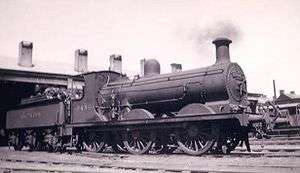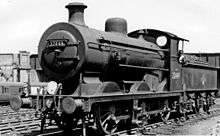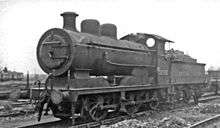LB&SCR C2 class
The London, Brighton and South Coast Railway C2 class was a class of 0-6-0 steam locomotives, intended for heavy freight trains. Fifty-five were built by the Vulcan Foundry between 1893 and 1902 to the design of Robert J. Billinton. Forty-five of these were later rebuilt between 1908 and 1940, with a larger boiler as the C2X class.
| LB&SCR C2 class | |||||||||||||||||||||||||
|---|---|---|---|---|---|---|---|---|---|---|---|---|---|---|---|---|---|---|---|---|---|---|---|---|---|
 C2 class 2436 at Brighton in 1948. | |||||||||||||||||||||||||
| |||||||||||||||||||||||||
| |||||||||||||||||||||||||
| |||||||||||||||||||||||||
| |||||||||||||||||||||||||
C2 class
In January 1891 Robert Billinton was given authority to build ten new 0-6-0 freight locomotives, to supplement Stroudley's C1 class of 1882-7. However, at the time, Brighton works was fully committed building Billinton's various classes of radial tanks and so tenders were sought from outside contractors. Ultimately the Vulcan Foundry agreed to construct these ten locomotives, and further orders were received at intervals until 55 had been purchased by February 1902. The class were therefore nicknamed 'Vulcans'.
The new class were not as powerful as their predecessors but were found to be both reliable and also capable of running at speed, thereby enabling them to be used on secondary passenger and excursion duties.[1] As a result, a further ten were ordered from Vulcan Foundry, which were delivered 1893-4, and twenty five delivered 1900-1902.
C2X class


During the first decade of the twentieth century the railway experienced a rapid growth in freight traffic and by 1905 their locomotives were no longer capable of hauling the heaviest trains without loss of time. Douglas Earle Marsh's initial response was to introduce his C3 class with a larger boiler in 1906, but the performance of these also proved to be disappointing.
However, in 1908 Marsh rebuilt one C2 with a larger diameter C3 steel boiler and an extended smokebox. In doing so he created an excellent powerful freight locomotive that was classified "C2X", and nicknamed 'Large Vulcans.' The modification was so successful that twenty-nine out of the original fifty-five members of the class were similarly rebuilt by the end of 1912.[2] By this time the class were beginning to struggle to keep time when hauling the heaviest freight trains and began to be superseded on these by the K class 2-6-0 in 1913/14, but were nevertheless kept very busy during the First World War on military supply and munitions trains, and three further C2’s had been rebuilt by the end of 1922.
After the First World War Lawson Billinton acquired ten spare boilers for the class incorporating his own top feed apparatus. These were clearly visible when fitted because of the presence of a second dome.[3]
Grouping and Nationalisation
All of the C2 and C2X locomotives passed to the Southern Railway in 1923, and nine further examples were rebuilt during 1924-5, as the original boilers became due for replacement. However, the trade recession of the early 1930s caused a decline in freight traffic resulting in the withdrawal of seven of the remaining C2 locomotives by the end of 1937. The advent of the Second World War meant that four other survivors were rebuilt in 1939 and 1940 and that the remaining three unrebuilt C2 locomotives remained in service until after the nationalisation of the railways to British Railways in 1948. Those remaining were all withdrawn between 1948 and 1950.
The C2X locomotives remained in regular use on secondary freight trains for a further decade and most had completed very impressive mileages for freight locomotives before they were all withdrawn between 1957 and February 1962. The last two examples were based at Three Bridges and Brighton and had completed =1,340,578 mi (2,157,451 km) and 1,279,527 mi (2,059,199 km) respectively.[4]
No examples have been preserved.
Accidents and incidents
- On 11 March 1905, locomotive No. 425 ran into the turntable pit at Tunbridge Wells, Kent.[5]
- On 18 April 1918, a freight train became divided, with the rear portion coming to a stand inside Redhill Tunnel. Owing to a signalman's error, a freight train hauled by locomotive No. 541 ran into it. A third freight train hauled by locomotive No. 536 ran into the wreckage.[6] The third train was carrying ammunition and explosives bound for Newhaven, but fortunately there was no fire and there were no serious injuries. It took forty hours to clear the potentially explosive debris from the tunnel.[7]
- On 19 November 1951, locomotive No. 32522 was hauling a freight train which was derailed between Cocking and Midhurst, West Sussex when an embankment was washed away. Recovery of the locomotive took more than three months.[5]
Locomotive Summary
| LBSC No. | 1st SR No. | 2nd SR No. | BR No. | Date Built | Date Rebuilt | Withdrawn |
|---|---|---|---|---|---|---|
| 433 | B433 | 2433 | February 1893 | November 1936 | ||
| 434 | B434 | 2434 | 32434 | February 1893 | November 1910 | March 1957 |
| 435 | B435 | 2435 | 32435 | March 1893 | March 1957 | |
| 436 | B436 | 2436 | 32436 | March 1893 | January 1950 | |
| 437 | B437 | 2437 | 32437 | April 1893 | November 1909 | January 1950 |
| 438 | B438 | 2438 | 32438 | April 1893 | February 1924 | December 1961 |
| 439 | B439 | 2439 | April 1893 | April 1937 | ||
| 440 | B440 | 2440 | 32440 | May 1893 | December 1911 | October 1958 |
| 441 | B441 | 2441 | 32441 | May 1893 | October 1912 | October 1961 |
| 442 | B442 | 2442 | 32442 | May 1893 | June 1922 | February 1960 |
| 443 | B443 | 2443 | 32443 | June 1893 | October 1924 | August 1960 |
| 444 | B444 | 2444 | 32444 | June 1893 | September 1910 | March 1960 |
| 445 | B445 | 2445 | 32445 | July 1894 | March 1911 | November 1961 |
| 446 | B446 | 2446 | 32446 | July 1894 | June 1912 | October 1960 |
| 447 | B447 | 2447 | 32447 | August 1894 | January 1911 | February 1960 |
| 448 | B448 | 2448 | 32448 | August 1894 | November 1912 | October 1961 |
| 449 | B449 | 2449 | 32449 | October 1894 | January 1912 | June 1961 |
| 450 | B450 | 2450 | 32450 | October 1894 | February 1911 | October 1961 |
| 451 | B451 | 2451 | 32451 | October 1894 | March 1924 | November 1961 |
| 452 | B452 | 2452 | November 1894 | October 1935 | ||
| 521 | B521 | 2521 | 32521 | August 1900 | January 1925 | December 1961 |
| 522 | B522 | 2522 | 32522 | August 1900 | September 1910 | October 1961 |
| 523 | B523 | 2523 | 32523 | August 1900 | April 1924 | February 1962 |
| 524 | B524 | 2524 | 32524 | September 1900 | October 1912 | March 1958 |
| 525 | B525 | 2525 | 32525 | September 1900 | December 1910 | January 1962 |
| 526 | B526 | 2526 | 32526 | September 1900 | June 1940 | February 1960 |
| 527 | B 527 | 2 527 | 32 527 | September 1900 | October 1939 | November 1960 |
| 528 | B 528 | 2 528 | 32 528 | October 1900 | September 1911 | February 1961 |
| 529 | B 529 | 2 529 | 32529 | October 1900 | April 1924 | September 1959 |
| 530 | B530 | 2530 | October 1900 | October 1935 | ||
| 531 | B531 | 2531 | October 1900 | March 1936 | ||
| 532 | B532 | 2532 | 32532 | October 1900 | July 1911 | May 1960 |
| 533 | B533 | 2533 | October 1900 | February 1950 | ||
| 534 | B534 | 2534 | 32534 | October 1900 | May 1911 | September 1961 |
| 535 | B535 | 2535 | 32535 | November 1900 | December 1939 | February 1962 |
| 536 | B536 | 2536 | 32536 | November 1900 | June 1924 | March 1961 |
| 537 | B537 | 2537 | 32537 | November 1900 | August 1924 | April 1957 |
| 538 | B538 | 2538 | 32538 | November 1900 | April 1910 | December 1961 |
| 539 | B539 | 2539 | 32539 | November 1900 | June 1924 | November 1961 |
| 540 | B540 | 2540 | 32540 | November 1900 | December 1922 | April 1958 |
| 541 | B541 | 2541 | 32541 | December 1901 | May 1910 | January 1961 |
| 542 | B542 | 2542 | December 1901 | January 1937 | ||
| 543 | B543 | 2543 | 32543 | December 1901 | October 1915 | October 1960 |
| 544 | B544 | 2544 | 32544 | December 1901 | January 1911 | November 1961 |
| 545 | B545 | 2545 | 32545 | December 1901 | July 1908 | December 1961 |
| 546 | B546 | 2546 | 32546 | January 1902 | June 1912 | April 1961 |
| 547 | B547 | 2547 | 32547 | January 1902 | October 1908 | November 1961 |
| 548 | B548 | 2548 | 32548 | January 1902 | March 1925 | November 1961 |
| 549 | B549 | 2549 | 32549 | January 1902 | October 1912 | December 1961 |
| 550 | B550 | 2550 | 32550 | January 1902 | November 1910 | December 1961 |
| 551 | B551 | 2551 | 32551 | February 1902 | February 1909 | February 1960 |
| 552 | B552 | 2552 | 32552 | February 1902 | January 1940 | June 1961 |
| 553 | B553 | 2553 | 32553 | February 1902 | October 1908 | August 1961 |
| 554 | B554 | 2554 | 32554 | February 1902 | April 1911 | February 1960 |
| 555 | B555 | 2555 | December 1901 | December 1937 |
References
- Bradley, D.L. (1974). Locomotives of the London Brighton and South Coast Railway, Part 3. Railway Correspondence and Travel Society. p. 97.
- Bradley, D.L. (1972). Locomotives of the London Brighton and South Coast Railway, Part 2. Railway Correspondence and Travel Society. pp. 97–108.
- Bradley (1974), p.103.
- Bradley (1972) p.108.
- Hoole, Ken (1983). Trains in Trouble: Vol. 4. Redruth: Atlantic Books. pp. 25, 40. ISBN 0 906899 07 9.
- Hoole, Ken (1982). Trains in Trouble: Vol. 3. Redruth: Atlantic Books. p. 22. ISBN 0-906899-05-2.
- Bradley, (1972), p.102.
External links
- Semg gallery
- Class C2 details; Rail UK
- Class C2X details; Rail UK